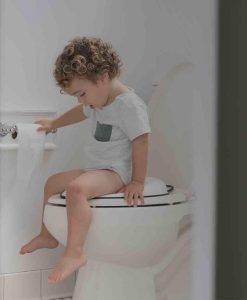Nighttime potty training can feel like a daunting task, but with the right approach, it can be a smooth transition for both you and your child. Here’s a comprehensive guide packed with nighttime potty training tips and tricks to help your little one achieve nighttime dryness.
Signs Your Child Might Be Ready
Before diving into nighttime potty training, it’s crucial to assess your child’s readiness. Here are some indicators to watch for:
- Daytime Success: Your child is consistently staying dry for several hours during the day.
- Waking Up Dry: They occasionally wake up from naps or nighttime sleep with a dry diaper.
- Expressing Interest: They show curiosity about using the potty at night or ask to go.
- Holding Their Bladder: They can hold their pee for longer stretches.
Getting Prepared for Nighttime Potty Training
Preparation is key to success! Here’s how to get yourselves ready:
Stock Up on Supplies:
Get waterproof mattress pads, washable bed sheets, and a potty chair for their room (optional).
Adjust Bedtime Routine:
Incorporate potty time right before putting on pajamas and another right before lights out.
Limit Fluids Before Bed:
Gradually reduce the amount of fluids your child drinks in the hour before bedtime.
Positive Reinforcement:
Praise and celebrate successes, no matter how small.
Nighttime Potty Training Strategies
Now that you’re prepared, let’s explore some effective strategies:
- Double Voiding: Have your child use the potty twice before bedtime, with a 15-minute interval between tries.
- Middle-of-the-Night Wake-Ups: Consider setting an alarm to wake up and take your child to the potty once during the night. This might be helpful initially but can be gradually phased out.
- Encourage Communication: Teach your child to tell you if they need to use the potty at night.
- Make it Accessible: Keep a small potty chair in their room for easy access if they wake up needing to go.
- Nighttime Accidents Happen: Stay calm and avoid making a big deal out of accidents. Focus on clean-up and getting them back to sleep.
Troubleshooting Nighttime Potty Training Hiccups
It’s normal to encounter setbacks along the way. Here’s how to handle them:
- Relapses Are Normal: Don’t get discouraged if your child has accidents. Take a step back and assess if they might be going through a stressful time or haven’t quite mastered daytime control yet.
- Address Underlying Medical Issues: If accidents are frequent, rule out any medical conditions that might be contributing to the problem.
- Stay Consistent: Maintain the nighttime potty routine even during setbacks. Consistency is key to building new habits.
Additional Tips for Success
Here are some extra pointers to consider:
- Involve Your Child: Let your child pick out fun underwear or a new potty chair to get them excited.
- Positive Reinforcement: Reward successes with stickers, praise, or a special bedtime story.
- Make Potty Time Fun: Read potty-themed books or sing songs during potty breaks.
- Be Patient: Nighttime potty training can take weeks or even months. Celebrate small victories and stay positive.
Nighttime potty training can be a rewarding experience for both parent and child. By following these tips and staying patient, you can help your little one achieve nighttime dryness and independence. Remember, every child develops at their own pace. Trust your instincts, adjust the strategies to fit your child’s needs, and most importantly, celebrate the journey together!
Potty-Training Tools and Techniques
Let’s explore some additional tools and techniques that can make nighttime potty training smoother:
-
Nighttime Underwear: Consider transitioning from diapers to nighttime underwear. These are absorbent but not leak-proof, which can help your child feel the wetness and associate it with needing to use the potty.
-
Positive Visualization: Before bed, talk to your child about using the potty successfully at night. Imagine them waking up dry and feeling proud.
-
Nightlight: A nightlight can help your child feel safe and navigate to the bathroom or potty chair more easily if they wake up needing to go.
-
Fluids and Diet: While limiting fluids before bed is helpful, avoid dehydrating your child. Offer water throughout the day and avoid sugary drinks close to bedtime that might increase urination.
-
Make it a Team Effort: If you have a partner, take turns handling nighttime wake-ups. This can help prevent one person from feeling overly tired.
Remember, every child is unique. Some children might grasp nighttime potty training quickly, while others take longer. Be patient, celebrate their progress, and focus on making the process positive and rewarding.

Building Independence and Confidence
Nighttime potty training is a journey towards independence for your child. Here are some tips to empower them and build confidence:
-
Involve them in the process: Let your child pick out fun pajamas with a big-kid theme or choose a new waterproof mattress pad with a cool design.
-
Practice makes progress: encourage your child to practice sitting on the potty before bed, even if they don’t go. This familiarity can build comfort and confidence for nighttime use.
-
Positive self-talk: Encourage your child to use positive affirmations before bed. Phrases like “My bladder is strong” or “I can use the potty at night” can boost their confidence.
-
Big kid bathroom breaks: If your child is interested, let them practice using the bathroom instead of a potty chair at night. This can be a big step towards independence.
-
Books and visuals: Read bedtime stories about potty training or create a sticker chart to track progress. Visual reminders can be motivating for children.

Addressing Common Concerns
Nighttime potty training can bring up questions and worries. Here’s how to address some common concerns:
-
Bedwetting Alarms: While bedwetting alarms can be effective for some children, they aren’t a magic solution. Discuss this option with your pediatrician and ensure your child understands the alarm’s purpose.
-
Sleep Deprivation: Nighttime accidents can disrupt sleep for both you and your child. Prioritize healthy sleep habits for everyone. Maintain a consistent bedtime routine and create a relaxing bedtime environment.
-
Regression: Accidents can happen even after progress is made. Avoid punishment and focus on positive reinforcement. It might be helpful to revisit some of the strategies that worked well previously.
-
Comparison to Others: Every child develops at their own pace. Resist comparing your child’s progress to others. Celebrate their individual achievements and focus on making the process positive.








